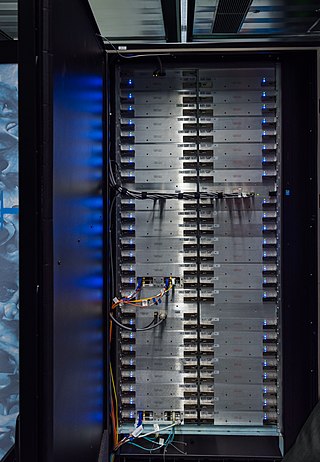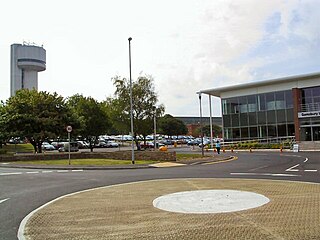Related Research Articles

A supercomputer is a computer with a high level of performance as compared to a general-purpose computer. The performance of a supercomputer is commonly measured in floating-point operations per second (FLOPS) instead of million instructions per second (MIPS). Since 2017, supercomputers have existed which can perform over 1017 FLOPS (a hundred quadrillion FLOPS, 100 petaFLOPS or 100 PFLOPS). For comparison, a desktop computer has performance in the range of hundreds of gigaFLOPS (1011) to tens of teraFLOPS (1013). Since November 2017, all of the world's fastest 500 supercomputers run on Linux-based operating systems. Additional research is being conducted in the United States, the European Union, Taiwan, Japan, and China to build faster, more powerful and technologically superior exascale supercomputers.
In computing, floating point operations per second is a measure of computer performance, useful in fields of scientific computations that require floating-point calculations. For such cases, it is a more accurate measure than measuring instructions per second.
Cray Inc., a subsidiary of Hewlett Packard Enterprise, is an American supercomputer manufacturer headquartered in Seattle, Washington. It also manufactures systems for data storage and analytics. Several Cray supercomputer systems are listed in the TOP500, which ranks the most powerful supercomputers in the world.

The National Energy Research Scientific Computing Center (NERSC), is a high-performance computing (supercomputer) National User Facility operated by Lawrence Berkeley National Laboratory for the United States Department of Energy Office of Science. As the mission computing center for the Office of Science, NERSC houses high performance computing and data systems used by 9,000 scientists at national laboratories and universities around the country. Research at NERSC is focused on fundamental and applied research in energy efficiency, storage, and generation; Earth systems science, and understanding of fundamental forces of nature and the universe. The largest research areas are in High Energy Physics, Materials Science, Chemical Sciences, Climate and Environmental Sciences, Nuclear Physics, and Fusion Energy research. NERSC's newest and largest supercomputer is Perlmutter, which debuted in 2021 ranked 5th on the TOP500 list of world's fastest supercomputers.

The TOP500 project ranks and details the 500 most powerful non-distributed computer systems in the world. The project was started in 1993 and publishes an updated list of the supercomputers twice a year. The first of these updates always coincides with the International Supercomputing Conference in June, and the second is presented at the ACM/IEEE Supercomputing Conference in November. The project aims to provide a reliable basis for tracking and detecting trends in high-performance computing and bases rankings on HPL benchmarks, a portable implementation of the high-performance LINPACK benchmark written in Fortran for distributed-memory computers.

Piz Daint is a mountain of the Swiss Ortler Alps, overlooking the Ofen Pass in the canton of Graubünden. The closest locality is Tschierv on the north side.
Shaheen is the name of a series of supercomputers owned and operated by King Abdullah University of Science and Technology (KAUST), Saudi Arabia. Shaheen is named after the Peregrine Falcon. The most recent model, Shaheen II, is the largest and most powerful supercomputer in the Middle East.
Nebulae is a petascale supercomputer located at the National Supercomputing Center in Shenzhen, Guangdong, China. Built from a Dawning TC3600 Blade system with Intel Xeon X5650 processors and Nvidia Tesla C2050 GPUs, it has a peak performance of 1.271 petaflops using the LINPACK benchmark suite. Nebulae was ranked the second most powerful computer in the world in the June 2010 list of the fastest supercomputers according to TOP500. Nebulae has a theoretical peak performance of 2.9843 petaflops. This computer is used for multiple applications requiring advanced processing capabilities. It is ranked 10th among the June 2012 list of top500.org.
The Swiss National Supercomputing Centre is the national high-performance computing centre of Switzerland. It was founded in Manno, canton Ticino, in 1991. In March 2012, the CSCS moved to its new location in Lugano-Cornaredo.
Supercomputing in India has a history going back to the 1980s. The Government of India created an indigenous development programme as they had difficulty purchasing foreign supercomputers. As of June 2023, the AIRAWAT supercomputer is the fastest supercomputer in India, having been ranked 75th fastest in the world in the TOP500 supercomputer list. AIRAWAT has been installed at the Centre for Development of Advanced Computing (C-DAC) in Pune.

Tsubame is a series of supercomputers that operates at the GSIC Center at the Tokyo Institute of Technology in Japan, designed by Satoshi Matsuoka.

Several centers for supercomputing exist across Europe, and distributed access to them is coordinated by European initiatives to facilitate high-performance computing. One such initiative, the HPC Europa project, fits within the Distributed European Infrastructure for Supercomputing Applications (DEISA), which was formed in 2002 as a consortium of eleven supercomputing centers from seven European countries. Operating within the CORDIS framework, HPC Europa aims to provide access to supercomputers across Europe.
The Cray XK6 made by Cray is an enhanced version of the Cray XE6 supercomputer, announced in May 2011. The XK6 uses the same "blade" architecture of the XE6, with each XK6 blade comprising four compute "nodes". Each node consists of a 16-core AMD Opteron 6200 processor with 16 or 32 GB of DDR3 RAM and an Nvidia Tesla X2090 GPGPU with 6 GB of GDDR5 RAM, the two connected via PCI Express 2.0. Two Gemini router ASICs are shared between the nodes on a blade, providing a 3-dimensional torus network topology between nodes. This means that it has 576 GB of Graphics memory and over 1500 CPU cores, several orders of magnitude more powerful than the best publicly available computer on the market.

Titan or OLCF-3 was a supercomputer built by Cray at Oak Ridge National Laboratory for use in a variety of science projects. Titan was an upgrade of Jaguar, a previous supercomputer at Oak Ridge, that uses graphics processing units (GPUs) in addition to conventional central processing units (CPUs). Titan was the first such hybrid to perform over 10 petaFLOPS. The upgrade began in October 2011, commenced stability testing in October 2012 and it became available to researchers in early 2013. The initial cost of the upgrade was US$60 million, funded primarily by the United States Department of Energy.

Appro was a developer of supercomputing supporting High Performance Computing (HPC) markets focused on medium- to large-scale deployments. Appro was based in Milpitas, California with a computing center in Houston, Texas, and a manufacturing and support subsidiary in South Korea and Japan.
XK7 is a supercomputing platform, produced by Cray, launched on October 29, 2012. XK7 is the second platform from Cray to use a combination of central processing units ("CPUs") and graphical processing units ("GPUs") for computing; the hybrid architecture requires a different approach to programming to that of CPU-only supercomputers. Laboratories that host XK7 machines host workshops to train researchers in the new programming languages needed for XK7 machines. The platform is used in Titan, the world's second fastest supercomputer in the November 2013 list as ranked by the TOP500 organization. Other customers include the Swiss National Supercomputing Centre which has a 272 node machine and Blue Waters has a machine that has Cray XE6 and XK7 nodes that performs at approximately 1 petaFLOPS (1015 floating-point operations per second).
The Cray XC30 is a massively parallel multiprocessor supercomputer manufactured by Cray. It consists of Intel Xeon processors, with optional Nvidia Tesla or Xeon Phi accelerators, connected together by Cray's proprietary "Aries" interconnect, stored in air-cooled or liquid-cooled cabinets. Each liquid-cooled cabinet can contain up to 48 blades, each with eight CPU sockets, and uses 90 kW of power. The XC series supercomputers are available with the Cray DataWarp applications I/O accelerator technology.

The Cray XC40 is a massively parallel multiprocessor supercomputer manufactured by Cray. It consists of Intel Haswell Xeon processors, with optional Nvidia Tesla or Intel Xeon Phi accelerators, connected together by Cray's proprietary "Aries" interconnect, stored in air-cooled or liquid-cooled cabinets. The XC series supercomputers are available with the Cray DataWarp applications I/O accelerator technology.

The Hartree Centre is a high performance computing, data analytics and artificial intelligence (AI) research facility focused on industry-led challenges. It was formed in 2012 at Daresbury Laboratory on the Sci-Tech Daresbury science and innovation campus in Cheshire, UK. The Hartree Centre is part of the Science and Technology Facilities Council (STFC) which itself is part of United Kingdom Research and Innovation (UKRI).
The Cray XC50 is a massively parallel multiprocessor supercomputer manufactured by Cray. The machine can support Intel Xeon processors, as well as Cavium ThunderX2 processors, Xeon Phi processors and NVIDIA Tesla P100 GPUs. The processors are connected by Cray's proprietary "Aries" interconnect, in a dragonfly network topology. The XC50 is an evolution of the XC40, with the main difference being the support of Tesla P100 processors and the use of Cray software release CLE 6 or 7.
References
- 1 2 November 2021 TOP500 Supercomputer Sites
- ↑ November 2016 TOP500 Supercomputer Sites
- ↑ Swiss National Supercomputing Centre, 19 June 2017 (page visited on 19 June 2017).
- ↑ Anna Maltsev and Felix Würsten, "Piz Daint is a world leader", ETH Zurich, 19 June 2017 (page visited on 19 June 2017).
- ↑ (in French) "Un superordinateur suisse au 3e rang mondial des machines de pointe", Swissinfo, 19 June 2017 (page visited on 19 June 2017).
- ↑ "TOP500 list refreshed, US edged out of third place", TOP500, 19 June 2017 (page visited on 19 June 2017).
- ↑ "Piz Daint - Cray XC50, Xeon E5-2690v3 12C 2.6GHz, Aries interconnect, NVIDIA Tesla P100 | TOP500". www.top500.org. Retrieved 2020-11-30.
- ↑ CSCS: Piz Daint Archived 2014-03-02 at the Wayback Machine
- ↑ CSCS: Piz Daint & Piz Dora